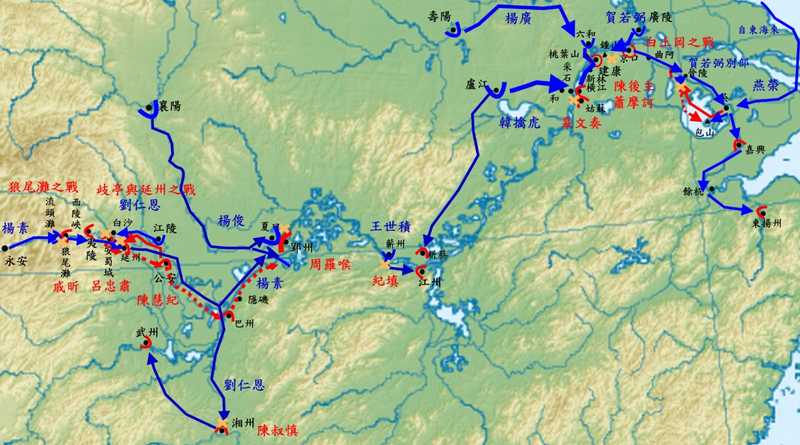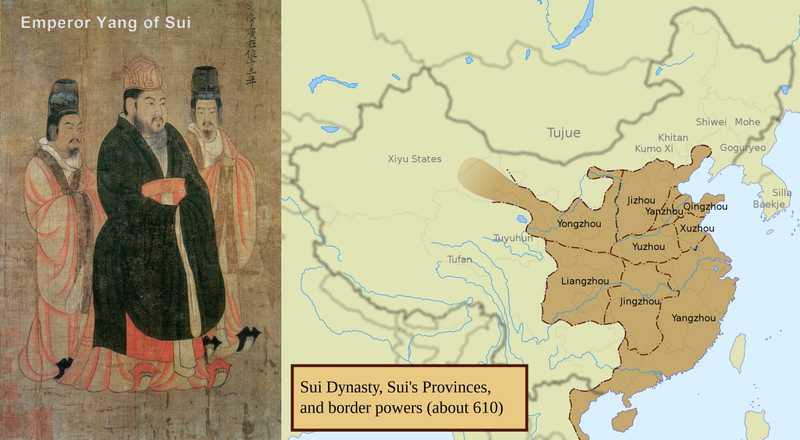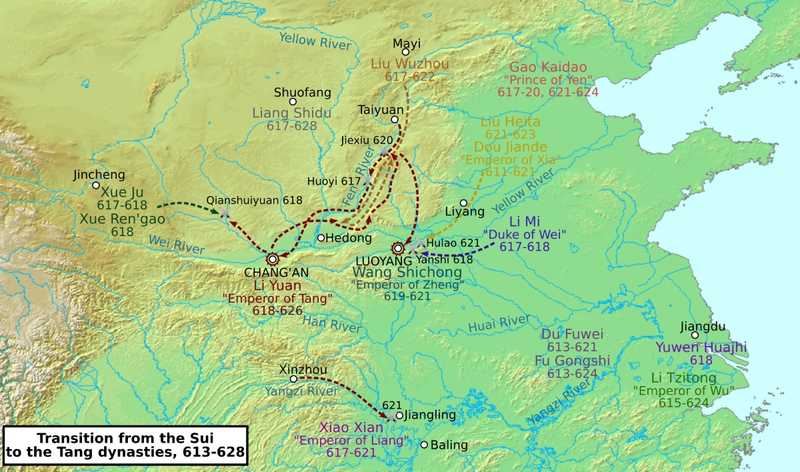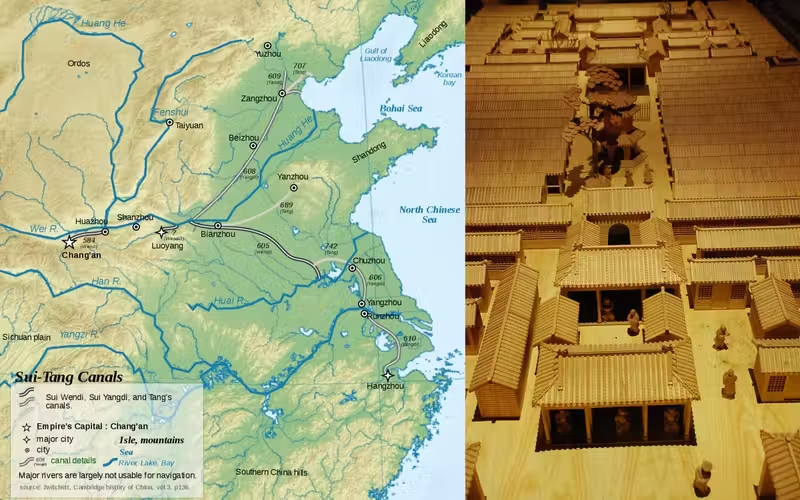Chinese Dynasty: Sui Dynasty (581-618 CE)
The Sui Dynasty (隋朝, Suí) was a brief but influential imperial era in China spanning from 581 to 618 CE. It marked the end of the turbulent Northern and Southern Dynasties (南北朝), bringing an end to the prolonged era of division that ensued after the collapse of the Western Jin Dynasty (西晋). This unification laid the crucial foundations for the subsequent much longer-lasting and prosperous Tang Dynasty (唐朝).
Under the rule of the Sui emperors, China experienced a brief but transformative era of unity, prosperity, and cultural exchange. This article explores the rise, achievements, and legacy of the Sui Dynasty, shedding light on its significant contributions to China's historical and cultural heritage.
Rise and Reunification

Battle of Sui and Chen, 588-589 CE
During the Northern Zhou Dynasty (北周), Emperor Xuan (北周宣帝) was indulgent in extravagance and debauchery, leading to political corruption. He had five empresses, among whom was Yang Jian's (杨坚) eldest daughter, Yang Lihua (杨丽华). As an influential relative, Yang Jian gradually took control of the government by dispatching key officials of the Northern Zhou court.
After the death of Emperor Xuan in 580 CE, Emperor Jing of Northern Zhou (北周静帝), who was still a child, succeeded and Yang Jian, who held a prominent position joined forces with Liu Fang (刘昉), and Zheng Yi (郑译) to assume power as a relative of the imperial family.
Emperor Jing abdicated the throne in favor of Yang Jian in 581 CE, who then established the Sui Dynasty (隋) and proclaimed himself Emperor, posthumously known as Emperor Wen of Sui (隋文帝). He relocated the capital to Daxing City (大兴城, i.e., Chang'an, present-day Xi'an, Shaanxi Province), marking the downfall of the Northern Zhou Dynasty.
Emperor Wen, whose clan claimed Han origins but had intermarried with the Xianbei (鲜卑) over generations, abolished the anti-Han policies of the Northern Zhou and reclaimed his Han surname of Yang (杨). He gained the support of Confucian scholars, who had held power in previous Han dynasties and were critical of the corruption under the nine-rank system (九品中正制). With their support, Emperor Wen initiated a series of reforms aimed at strengthening the empire in preparation for the wars that would ultimately reunify China.
Emperor Wen led a successful campaign to conquer Chen (南陈) in the south. He used strategic disruptions to Chen's agricultural and military resources, leading to significant losses for Chen. After defeating the Turks (突厥) and abolishing Western Liang (西梁), Emperor Wen launched an offensive in 588 CE with multiple routes attacking Chen. The Sui forces successfully captured Jiankang (建康) in 589 CE, marking the end of Chen. Subsequently, emissaries were sent to pacify unconquered southern regions, resulting in the complete unification of China under the Sui Dynasty by 590 CE.
Reign of Kaihuang (开皇之治, 581-604 CE)

Main politics surrounding the Sui Dynasty in 600 CE
During the reign of Emperor Wen (581-604 CE), he implemented various reforms to promote thrift and efficiency in the government. He abolished unnecessary taxes and established granaries to store food supplies.
He appointed officials based on merit rather than social status and introduced examinations to select talented individuals. The legal system was reformed, reducing harsh punishments and emphasizing rehabilitation.
Economically, Emperor Wen continued the equal-field system (均田制) from the Northern Wei Dynasty (北魏), distributing land to male peasants and reducing taxes and labor obligations, alleviating the burdens on the people. He also focused on agricultural development and grain storage to ensure food security.
In terms of culture, he encouraged education, collected and organized books, and reestablished Confucian rituals and music to promote Chinese culture.
In military matters, Emperor Wen addressed the threat of the powerful Turkic forces by launching military campaigns and employing strategies to divide and weaken them.
As a result of these reforms, Emperor Wen's reign saw a period of prosperity and growth, known as the Reign of Kaihuang (开皇之治), with a clear and efficient government, a growing population, a strong treasury, and reduced external threats. This period is considered the zenith of the Sui Dynasty.
However, during the later years of the Sui Dynasty, Emperor Wen's prosperous reign began to decline. He became harsh in his use of the legal system and grew suspicious of his loyal officials, leading to a series of purges and executions.
In terms of succession, he initially favored his eldest son, Yang Yong (杨勇), but later changed his mind due to Yang Yong's extravagant behavior. Yang Guang (杨广), the second son, conspired against Yang Yong and gained Emperor Wen's trust. In 600 CE, Yang Guang was named the crown prince, and in 602 CE, Yang Xiu (杨秀), another son, was falsely accused and deposed.
Emperor Wen passed away suddenly in 604 CE, and Yang Guang ascended the throne as Emperor Yang (隋炀帝). He executed Yang Yong and his sons and suppressed rebellions from his younger brother, Yang Liang (杨谅).
A Short Period of Prosperity under Emperor Yang

A portrait of Emperor Yang and map of Sui, 610 CE
During the early reign of Emperor Yang of the Sui Dynasty (隋炀帝), the empire remained strong. He reformed the government system, and taxation, and established the imperial examination system (科举制).
He also initiated various ambitious projects, such as building the eastern capital, Luoyang (洛阳), constructing the Grand Canal (大运河) to connect north and south China, repairing roads, and extending the Great Wall (长城). These endeavors stimulated economic, social, and cultural exchanges and trade between different regions, while also expanding the territory of the Sui Dynasty. However, Emperor Yang's impatient and ambitious approach caused societal damage.
Emperor Yang focused on strengthening communication between the North and South, as well as consolidating the empire's control over different regions. The construction of the Grand Canal facilitated transportation, creating a vital network linking various waterways and promoting economic and cultural exchanges. Yet, the hasty construction imposed significant burdens on the people, leading to numerous deaths and hardships for laborers.
He also launched ambitious military campaigns to expand the territory of the Sui Dynasty. Among them, the campaign against Goguryeo (高句丽) further depleted the resources of the empire and led to widespread discontent among the people. He extensively recruited laborers and soldiers, leading to further strain on the population.
Emperor Yang's aggressive policies also led to conflicts with neighboring countries. The Sui Dynasty faced invasions and rebellions from regions like the northern frontier and the Korean Peninsula. Eventually, the costly and unsuccessful military expeditions against Goguryeo, coupled with internal rebellions, contributed to the downfall of the Sui Dynasty.
Civil Uprising and Downfall

Map of Northern China during the transition from Sui to Tang
Emperor Yang launched multiple wars that strained the people and depleted the treasury, leading to a severe crisis of governance.
In 610 CE, the sixth year of his reign, four uprisings occurred due to the resistance against conscription into the compulsory military service system. However, these rebellions were quickly suppressed by the Sui forces.
In 611 CE, the Yellow River flooded several provinces, and Wang Bo (王薄) led a rebellion in response to the excessive demands of Emperor Yang's campaign against Goguryeo, famously singing the "Don't Die in the Waves of Liaodong" song (《无向辽东浪死歌》).
During this time, various rebel forces emerged across the country, including separate forces in Henan (河南), Hebei (河北), Jianghuai (江淮), and the central military stronghold of Bingzhou (并州).
The leader of the Bingzhou force, Li Yuan (李渊), later launched the Jinyang Uprising (晋阳起兵) and took over Chang'an in 617 CE, proclaiming Yang You (杨侑), the third grandson of Emperor Wen, as Emperor, known as Emperor Gong of Sui (隋恭帝). Li Yuan assumed the title of Prime Minister (丞相) and was further enfeoffed as the King of Tang (唐王).
These uprisings created a situation of fragmentation, with various warlords and leaders establishing their own regimes. Emperor Yang's government rapidly collapsed. In 618 CE, with the revolt of the officials and generals, Emperor Yang was assassinated, and Yang Hao (杨浩) was declared the new emperor. Meanwhile, in the central region, Li Yuan forced Emperor Gong's abdication and proclaimed himself Emperor of the Tang Dynasty, posthumously known as Emperor Gaozu of Tang (唐高祖).
Meanwhile, the "Seven Nobles" (七贵), who were in charge of the defense of the capital city Luoyang, learned about the death of Emperor Yang and enthroned Yang Tong (杨侗), a grandson of Emperor Yang, as the new emperor. He is commonly referred to as the Last Emperor of Sui. However, just a year later, in 619 CE, Yang Tong was deposed and killed, marking the end of the Sui Dynasty after only 38 years, and the Tang Dynasty emerged as the new ruling power.
Influence and Legacy

Left: the Grand Canal under the Sui and Tang Dynasties. Right: a model of exam cells displayed at Beijing Imperial Academy.
During the rather short reign of the Sui Dynasty, significant reforms were implemented in the realms of politics, economy, culture, and diplomacy, which had a profound influence for the centuries to come.
Politically, the Sui Dynasty established the Three Departments and Six Ministries system (三省六部制), consolidating centralized power. They officially introduced the imperial examination system (科举制) to select talented individuals and weaken the monopoly of aristocratic families in government positions. New institutions such as the Political Affairs Hall, supervisory system, and performance evaluation system were established to strengthen the government's efficiency, drawing from the experiences of the Northern and Southern Dynasties.
To strengthen the development of the Sui Dynasty, Emperor Wen and Emperor Yang undertook the construction of the Grand Canal (大运河), the Great Wall, and the imperial roads, as well as the cities of Daxing and Luoyang. These projects enhanced the Sui court's control over the northern, eastern, and southern regions from its central location. It facilitated smooth economic, cultural, and social exchanges between different parts of the Sui Dynasty and gave rise to the thriving economic hub of Jiangdu (江都, present-day Yangzhou).
Economically, they implemented the equal-field system (均田制) and reformed taxation and corvée labor to alleviate the burden on farmers. The government also introduced measures like household registration inspections to increase fiscal revenue.
As for the military, the Sui Dynasty continued to refine the garrison system, ensuring a well-organized defense force.
The influence of Sui extended beyond its borders, as neighboring countries such as Gaochang (高昌), Japan (倭国), Goguryeo (高句丽), Silla (新罗), Baekje (百济), and Eastern Turkic Khaganate (东突厥) were deeply impacted by Chinese culture and systems. Notably, Japan sent missions to Sui, marking a famous example of such cultural exchange.
The Sui Dynasty put an end to the fragmented state of China since the Wei (魏), Jin (晋), and Northern and Southern Dynasties (南北朝), laying the foundation for the prosperous era of the Tang Dynasty (唐朝).
The Sui Dynasty also displayed a high level of acceptance of foreign cultures and successfully integrated them with Han culture, which contributed to its reputation as one of the more open dynasties in Chinese history, along with the Tang Dynasty.